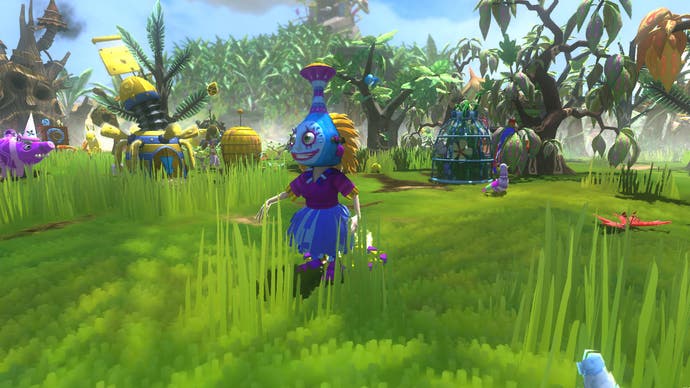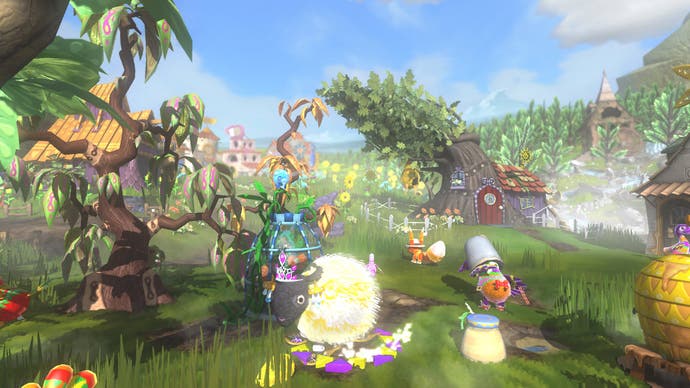The Kids Are Alright
TT Games, Rare and Insomniac discuss the art of developing games for children.
Rare's George Andreas also favours the nurturing approach. "I think the key thing is that you structure such mechanics in a way that kids can understand and want to understand," he says. "A simple concept can prove to be daunting to a younger player if it is structured poorly, yet if you approach complex mechanics correctly, kids can understand much more than a lot of people expect."
"How you entertain younger players, or where this entertainment comes from, often does have differences when compared to older players. You have to allow them to do what they want, even if it's not playing the game properly. Younger players have a great ability to create their own entertainment and some of the ways they play your games is very surprising, but also extremely refreshing.
"Another difference is how younger players see goals in games. They are much less likely to aspire to a long-term goal, preferring to favour lots of varied and short-term ones. However, with clever design, you can still make them reach that long-term goal by structuring it as a series of short-term ones. If there is a long-term goal, the goal is better as something that can be 'seen' and 'owned'."
This is something integral not just to videogames but to the concept of "play" in general. For boys in particular, the competitive nature of games - whether against other people or a games console - is all about progress and acquisition. "Boys play video games for territory typically," says Frank Gaskill, a child psychologist from North Carolina cool enough to give shout-outs to Metallica, Luke Skywalker and George Romero on his website.

"They have brains that get 'turned on' by conquering and controlling territory. It's a kind of empire thought process. Moving up the ladder of success appears to be very powerful and associated with socialisation, bragging rights and personal success experiences." In other words, beating a game, gaining Achievements or reaching goals is fun because it taps into and feeds an important part of our behavioural brain chemistry. We're built to play.
It seems that in recent years, certainly within the last few console generations, that the advance in graphical muscle has ghettoised the younger gamer, with design elements that were once traditional across most games now out of favour in a market that focuses largely on grey-and-brown shooters where the only primary colours come from garish gouts of blood.
Once upon a time there wasn't really such a thing as kids games - there were just games, and almost all of them were suitable for kids even if they weren't created with them in mind. Given that the AAA titles these days tend to be action-heavy games for teens and older, do the designers of today's best games for kids even consider them to be "kids games"?
"Most of the games in the early age of gaming were kids games, even if they weren't," argues Rare's George Andreas. "The limited graphical capabilities and the use of bright colours made it easy for people that didn't play games to label all games as kids games. Many games today that retain the use of bright colours are still seen as kids' games (again, even if they are not) because games aimed at teens and above often favour less colourful palettes.

"Viva Piñata and Banjo-Kazooie have very colourful palettes and are often regarded as kids' games, but speak to anyone that has played either and they'll hopefully tell you they are far more than that.
"I also think the criteria of a game 'designed for everyone' has broadened and changed over time. In the early days of gaming, 'everyone' simply meant 'everyone that regularly played games'. Now I would say that 'everyone' means 'everyone that plays, from as little as once a year to those that play all year'. This is a much wider scope and far fewer games fit into this category. As approachable as Viva Piñata and Banjo-Kazooie are, I would have to say they are classic rather than modern interpretations of 'games for everyone'."
"I am surprised by the ratio of games that tend to appeal to older gamers," agrees Insomniac's Brian Allgeier, whose studio also produces the bloody Resistance series. "I think many young players are either playing more mature games (which is unfortunate) or they're playing games outside of the standard consoles like on the web or portables. In the future it's very possible that most games will be played on the web or on portables and consoles won't exist. I guess that means that kids would be leaving us older gamers behind..."
I tend to feel that it's not so much that kids are leaving us older gamers behind, but that they're perhaps closer to what made us fall in love with gaming, still experiencing that early gaming rush that we're trying to reclaim as middle age rushes to meet us like a brick to the face.
While I was researching and writing this feature, my son was starting over on Banjo-Kazooie: Nuts & Bolts using a new profile. He was as excited and inspired as the first time he played it, quickly drawn back into the ingenious overlapping systems of encouragement and reward that define the best games, not just for his age group but for all players.
His generation of gamers, and those who will follow, are simply experiencing an entertainment media that is now more elegant and evolved than the slightly awkward, wobbling baby fawn that was the games industry of the 1970s and 1980s. At their best, today's games for children are remarkable engines of inspiration and imagination, produced by people who understand the responsibility that power confers. That's why I'll always prefer see my son with a joypad in his hand than a TV remote.
Jonathan Smith is head of production at Traveller's Tales, Brian Allgeier is design director at Insomniac Games, George Andreas is design director at Rare and Frank Gaskill is a child psychologist. Dan Whitehead is Dan Whitehead, and we love him.
